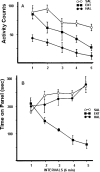The behavioral pharmacology of effort-related choice behavior: dopamine, adenosine and beyond
- PMID: 22287808
- PMCID: PMC3266736
- DOI: 10.1901/jeab.2012.97-125
The behavioral pharmacology of effort-related choice behavior: dopamine, adenosine and beyond
Abstract
For many years, it has been suggested that drugs that interfere with dopamine (DA) transmission alter the "rewarding" impact of primary reinforcers such as food. Research and theory related to the functions of mesolimbic DA are undergoing a substantial conceptual restructuring, with the traditional emphasis on hedonia and primary reward yielding to other concepts and lines of inquiry. The present review is focused upon the involvement of nucleus accumbens DA in effort-related choice behavior. Viewed from the framework of behavioral economics, the effects of accumbens DA depletions and antagonism on food-reinforced behavior are highly dependent upon the work requirements of the instrumental task, and DA-depleted rats show a heightened sensitivity to response costs, especially ratio requirements. Moreover, interference with accumbens DA transmission exerts a powerful influence over effort-related choice behavior. Rats with accumbens DA depletions or antagonism reallocate their instrumental behavior away from food-reinforced tasks that have high response requirements, and show increased selection of low reinforcement/low cost options. Nucleus accumbens DA and adenosine interact in the regulation of effort-related functions, and other brain structures (anterior cingulate cortex, amygdala, ventral pallidum) also are involved. Studies of the brain systems regulating effort-based processes may have implications for understanding drug abuse, as well as symptoms such as psychomotor slowing, fatigue or anergia in depression and other neurological disorders.
Keywords: adenosine; behavioral economics; dopamine; effort; reinforcement; review; work.
Figures



References
-
- Aberman J.E, Salamone J.D. Nucleus accumbens dopamine depletions make rats more sensitive to high ratio requirements but do not impair primary food reinforcement. Neuroscience. 1999;92:545–552. - PubMed
-
- Allison J. Economics and operant conditioning. In: Harzem P, Zeiler M.D, editors. Predictability, correlation and contiguity. New York: John Wiley and Sons; 1981. pp. 321–353. (Eds.)
-
- Amtage J, Schmidt W.J. Context-dependent catalepsy intensification is due to classical conditioning and sensitization. Behavioural Pharmacology. 2003;14:563–567. - PubMed
-
- Anstrom K.K, Woodward D.J. Restraint increases dopaminergic burst firing in awake rats. Neuropsychopharmacology. 2005;30:1832–1840. - PubMed
Publication types
MeSH terms
Substances
Grants and funding
LinkOut - more resources
Full Text Sources

